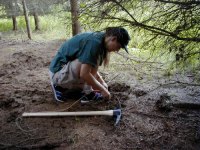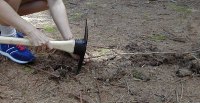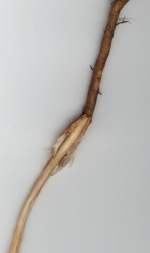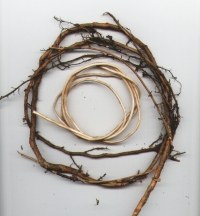
 |
 No
nails or screws are used to hold a birchbark canoe together. Instead, the pieces
are lashed together with peeled and split tree roots, usually from spruce trees,
although pine roots can be used too.
No
nails or screws are used to hold a birchbark canoe together. Instead, the pieces
are lashed together with peeled and split tree roots, usually from spruce trees,
although pine roots can be used too.
I used roots from white spruce trees (Picea glauca) from an abandoned Christmas tree plantation.
Here I am pulling up spruce roots (click on the pictures to see them bigger). The pick axe is used at first to pull up a root. Then the root is gradually pulled out of the ground, following it as it goes under and over other roots. For a canoe, the roots need to be about the size of a finger. I also use smaller roots for model canoes.
 The
best place to get spruce roots is in sandy soil where the trees are not too
close together. Where I collected my roots the trees are quite close together
and the roots are intertwined, making digging them up harder. I expect that
in sandy soil too the roots would be straighter.
The
best place to get spruce roots is in sandy soil where the trees are not too
close together. Where I collected my roots the trees are quite close together
and the roots are intertwined, making digging them up harder. I expect that
in sandy soil too the roots would be straighter.
When I was building my canoe I found I needed roots about 6 feet long for each lashing. The books say you can find roots up to 20 feet long but I have succeeded in digging up any that long.
 Once
you have a bunch of roots, take them home and peel the bark
Once
you have a bunch of roots, take them home and peel the bark off them right away. It's much easier to peel them fresh than to peel them once
they have dried. Some people split them and then peel them and others peel and
then split. I tried both methods and ended up peeling first.
off them right away. It's much easier to peel them fresh than to peel them once
they have dried. Some people split them and then peel them and others peel and
then split. I tried both methods and ended up peeling first.
On the left is a root with the bark partly peeled off. On the right are unpeeled and peeled roots. Click on the pictures to see them bigger.
To peel the bark off roots you can use your fingernails or a piece of wood with a notch cut in it, or two pieces of wood held together. The idea is to scrape the bark off but not damage the inner root. Once the roots are peeled and split, roll them up to store them.
When you are ready to use them, soak them in a bit of warm water for a few minutes until them are flexible.
Back to the Materials page
© Judy Kavanagh 2001